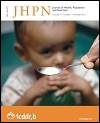Caretakers Perception towards Using Zinc to Treat Childhood Diarrhoea in Rural Western Kenya
DOI:
https://doi.org/10.3329/jhpn.v31i3.16823Keywords:
Acceptability, Community treatment, Diarrhoeal disease, Zinc, KenyaAbstract
Zinc treatment for diarrhoea can shorten the course and prevent future episodes among children worldwide. However, knowledge and acceptability of zinc among African mothers is unknown. We identified children aged 3 to 59 months, who had diarrhoea within the last three months and participated in a home-based zinc treatment study in rural Kenya. Caretakers of these children were enrolled in two groups; zinc-users and non-users. A structured questionnaire was administered to all caretakers, inquiring about knowledge and appropriate use of zinc. Questions on how much the caretakers were willing to pay for zinc were asked. Proportions were compared using Mantel-Haenszel test, and medians were compared using Wilcoxon Rank Sum test. Among 109 enrolled caretakers, 73 (67%) used zinc, and 36 (33%) did not. Sixty-four (88%) caretakers in zinc-user group reported satisfaction with zinc treatment. Caretakers in the zinc-user group more often correctly identified appropriate zinc treatment (98%-100%) than did those in the non-user group (64-72%, p<0.001). Caretakers in the zinc-user group answered more questions about zinc correctly or favourably (median 10 of 11) compared to those in the non-user group (median 6.3 of 11, p<0.001). Caretakers in the zinc-user group were willing to pay more for a course of zinc in the future than those in the non-user group (median US$ 0.26, p<0.001). Caretakers of children given zinc recently had favourable impressions on the therapy and were willing to pay for it in the future. Active promotion of zinc treatment in clinics and communities in Africa could lead to greater knowledge, acceptance, and demand for zinc.
DOI: http://dx.doi.org/10.3329/jhpn.v31i3.16823
J HEALTH POPUL NUTR 2013 Sep; 31(3): 321-329
Downloads
834
506

